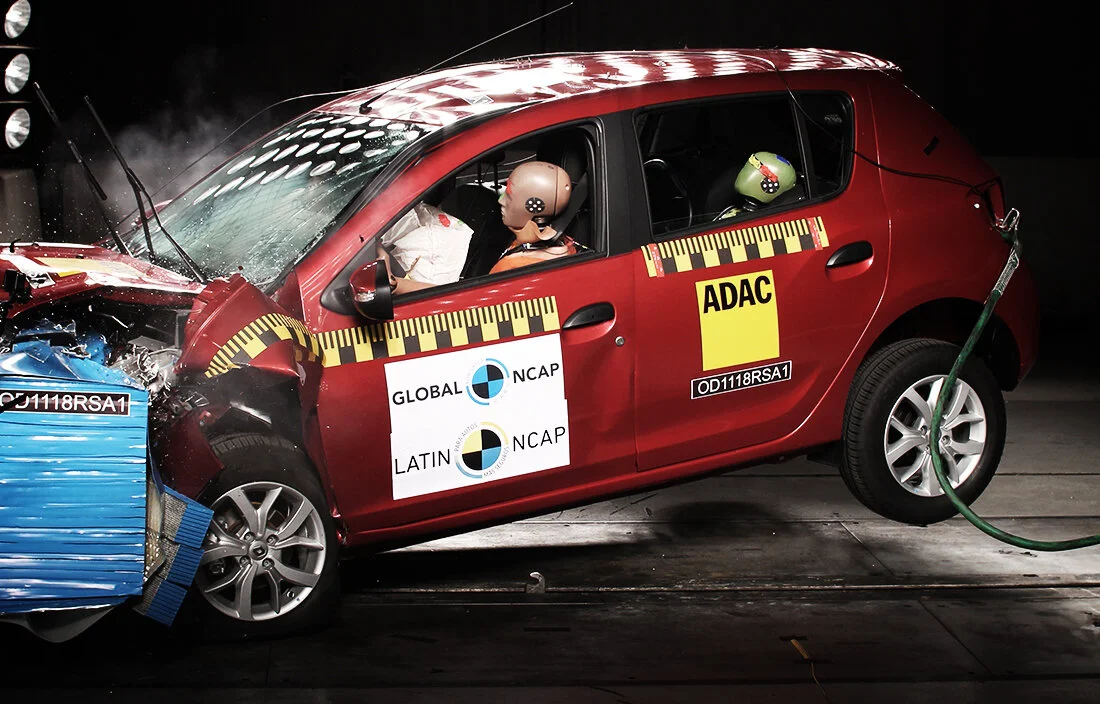Sandero/Logan Keeps One Star While Mitsubishi Eclipse Cross Gets Five Stars
Latin NCAP’s third round of results for 2018 was released today with encouraging results from the recently launched Mitsubishi Eclipse Cross with five stars for adults and three stars for child protection and once again a disappointing result for the Renault Sandero/Logan achieving just one star for adult protection and three for child occupant protection.
The recently launched Mitsubishi Eclipse Cross achieved five stars for Adult Occupant Protection and three stars for Child Occupant Protection. The Eclipse Cross offered good protection for the adults in frontal, side and side pole impact while it also pass the Electronic Stability Control (ESC) regulatory test. The Eclipse Cross offers 7 airbags as standard equipment being one of them for driver’s knees. The Child Occupant Protection rating of three stars is explained by the selection of the Child Restraint Systems (CRS) used in the test, which could only be adjusted using seatbelts causing low protection in both child dummies. The manufacturer decided not to make available CRS with ISOFIX anchorages ahead of the test even and for this reason they could not be used, though the car offers standard ISOFIX anchorages I-size approved. It is likely that this car with ISOFIX child seats would have shown better results. All of the CRSs tested for installation pass. The car also offers 3 points belts in all seating positions.
The popular Renault Sandero/Logan achieved just one star for Adult Occupant Protection and three stars for Child Occupant Protection. The Sandero/Logan offered poor protection to the driver chest in the frontal and side impact which explained the one star for Adult Occupant Protection. Although the Sandero/Logan have side door bars, the lack of a better performing structure and energy absorption devices for side impact explain the poor side impact performance. The Sandero/Logan still does not offer 3 point belts in all seating positions as standard and no ISOFIX anchorages as standard which is surprising considering that the recently Sandero for Africa, tested by Global NCAP, does offer 3 point belts in all seats and ISOFIX as standard. Renault confirmed they will improve the Sandero/Logan’s safety performance.
Alejandro Furas, Secretary General of Latin NCAP said:
“It is encouraging to find more five star models in the region; however, child occupant protection still does not have the same priority as adult occupant protection for some manufacturers. It is a huge concern for Latin NCAP that still one of the best-selling models in the region like the Sandero/Logan offers such a low protection level lacking of ESC, and minimum side impact protection.
Our work showed that testing models, publishing their results to properly inform consumers is the most powerful and efficient tool that is already pushing Latin American market to safer cars beyond and earlier than governments regulations. Large part of this change is thanks to consumers and fleet managers. Governments should encourage and promote mandatory rating for all cars sold in their markets to speed up the change to safer cars. Governments should encourage and create incentives to cars with active safety technologies like ESC and Autonomous Emergency Braking systems.”
Ricardo Morales Rubio, Latin NCAP Chairman of the Board of Directors said:
“Latin NCAP latest results clearly show the consequences of the lack of solid regulations throughout the Latin America and the Caribbean region. Best selling cars can still get upsetting results and this is unacceptable for consumers. We encourage improvements of these models to be done as soon as possible in order to assume clear corporate responsibility actions that will be returned in saving lives”.
Mitsubishi Eclipse Cross
Read the full crash test report
Download crash test video
Download ESC test video
Download crash test images
Renault Sandero/Logan
Read the full crash test report
Download the crash test video
Download crash test images
About Latin NCAP
The New Car Assessment Programme for Latin America and the Caribbean, Latin NCAP, was launched in 2010 to develop a regional system of independent crashworthiness and safety rating across Latin America and Caribbean (LAC). Latin NCAP replicates similar consumer testing programmes developed over the last thirty years in North America, Europe, Asia and Australia, and which have proved to be very effective in improving the safety of motor vehicles. Since 2010 Latin NCAP has published the results of more than ninety cars in nine test phases.
Latin NCAP acknowledges the support received by the Global New Car Assessment Programme (Global NCAP), International Consumer Research and Testing (ICRT), FIA Foundation, the Inter-American Development Bank (IDB) and Bloomberg Philanthropies Global Road Safety Initiative.
Latin NCAP is an Associate member of Global NCAP and supports the United Nations Decade of Action for Road Safety 2011-2020 and the Stop the Crash Partnership.
More info: www.latinncap.com






